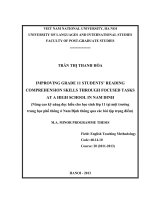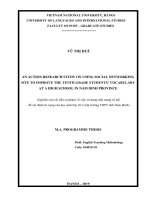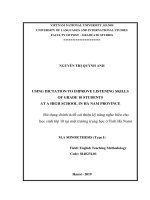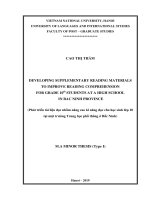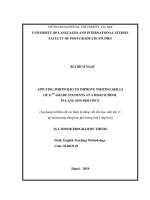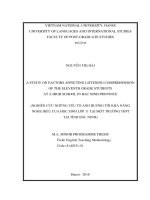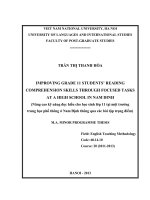Efl 11th grade students listening comprehension difficulties and their strategies a study at a high school in binh dinh province
Bạn đang xem bản rút gọn của tài liệu. Xem và tải ngay bản đầy đủ của tài liệu tại đây (980.88 KB, 84 trang )
MINISTRY OF EDUCATION AND TRAINING
QUY NHON UNIVERSITY
LE THI THU THAO
EFL 11TH GRADE STUDENTS' LISTENING
COMPREHENSION DIFFICULTIES AND THEIR
STRATEGIES- A STUDY AT A HIGH SCHOOL IN BINH
DINH PROVINCE
Major: Theory and Methodology of English Language Teaching
Code: 8140111
SUPERVISOR: DR. VO DUY DUC
BỘ GIÁO DỤC VÀ ĐÀO TẠO
TRƢỜNG ĐẠI HỌC QUY NHƠN
LÊ THỊ THU THẢO
NHỮNG KHÓ KHĂN VÀ CÁC CHIẾN LƢỢC HỌC KỸ
NĂNG NGHE CỦA HỌC SINH LỚP 11- MỘT NGHIÊN CỨU
TẠI MỘT TRƢỜNG THPT Ở TỈNH BÌNH ĐỊNH
Ngành: Lý luận và phƣơng pháp dạy học bộ môn tiếng Anh
Mã số: 8140111
Ngƣời hƣớng dẫn: TS. VÕ DUY ĐỨC
i
STATEMENT OF AUTHORSHIP
The thesis entitled "EFL 11th grade Students' Listening Comprehension
Difficulties and their Strategies" is conducted under Dr. Vo Duy Duc, a lecturer at
Quy Nhon University. I declare that the information this study reports results from
my work and effort. The thesis has not been accepted for any degree and has not
concurrently submitted to any candidature for any degree or diploma.
Quy Nhon, 2023
LE THI THU THAO
ii
ACKNOWLEDGEMENT
Without the support, encouragement, and contributions from my teacher,
colleagues, friends, students, and family, this thesis work would not have been
successful. I sincerely thank and respect everyone who gave me advice and helped
me with this research.
First, I would like to sincerely thank Dr. Vo Duy Duc, my supervisor, for his
fantastic supervision. His outstanding knowledge and professional teaching-related
expertise inspired me greatly during my academic life at Quy Nhon University, and
he opened new horizons for me in the field. I appreciate his helpful guidelines and
suggestions, extraordinary patience, and strong management skills in assisting me in
resolving the obstacles while I carried out my thesis. Without his valuable advice
and support, this study could not have been completed on schedule. I feel fortunate
to have had his support for my work.
Secondly, I would also like to express my full appreciation to all teachers and
students at Nguyen Dinh Chieu high school who participated in my study for their
support in completing the survey questionnaire.
Last but not least, I am grateful for all the support and encouragement from
my beloved parents and husband throughout my thesis. Their love and
encouragement helped me overcome the difficult times during my studies. I could
not have completed this project without their intense devotion.
iii
ABSTRACT
This study aims to discover students‟ listening comprehension difficulties and
the strategies that 11th-grade students at Nguyen Dinh Chieu high school encounter
when they learn listening skills. The study was conducted with a survey, interview,
and classroom observation for data collection. Specifically, this study involved 80
grade 11 students in a high school in Binh Dinh. The findings show that fourteen
problems cause difficulties for 11th-grade students. The problems have been
classified into four categories, namely (1) problems related to bottom-up
processing, (2) problems related to top-down processing, (3) problems related to
materials and listening tasks, and (4) other problems, besides the research exposed
strategies that 11th- grade students applied to solve these difficulties. These included
participating in extracurricular activities for students, getting support and feedback
from the teachers, learning listening by using modern technology, learning
vocabulary more at home, etc. It could be said that this study provided insights into
EFL 11th-grade students' challenges when learning listening skills. A clear
understanding of these difficulties and strategies could help students create effective
learning environments for their language learning, especially the listening skills for
EFL 11th-grade students.
iv
TABLE OF CONTENT
STATEMENT OF AUTHORSHIP .................................................................... i
ACKNOWLEDGEMENT................................................................................ ii
ABSTRACT .................................................................................................... iii
TABLE OF CONTENT ................................................................................... iv
LIST OF TABLE ............................................................................................ vii
LIST OF CHART .......................................................................................... viii
CHAPTER 1: INTRODUCTION ................................................................. 1
1.1. Research rationale.................................................................................. 1
1.2. Aim and objectives of the study ............................................................ 3
1.2.1. Aim of the study ............................................................................. 3
1.2.2. Objectives of the study ................................................................... 3
1.3. Research questions ................................................................................ 3
1.4. Scope of the study.................................................................................. 3
1.5. Significance of the study ....................................................................... 3
1.6. The organization of the thesis................................................................ 4
CHAPTER 2: LITERATURE REVIEW ..................................................... 5
2.1. Theoretical background ......................................................................... 5
2.1.1. Definition of Listening Skills ......................................................... 5
2.1.2. Definition of listening strategies..................................................... 7
2.1.3. Importance of listening skills ......................................................... 9
2.1.4. Types of Listening ........................................................................ 11
2.1.5. Listening strategies ....................................................................... 11
2.1.6. Strategies for learning to listen ..................................................... 14
2.2. Procedures of a Listening Lesson in a Language Classroom .............. 17
2.2.1. Pre-listening.................................................................................. 17
2.2.2. While- listening ............................................................................ 17
2.2.3. Post-listening ................................................................................ 18
2.3. Major problems students face in learning to listen to English ............ 18
v
2.3.1. Problem-related to bottom-up processing..................................... 18
2.3.2. Problems related to top-down processing..................................... 24
2.4. Factors affecting the effectiveness of learning listening skills ............ 29
2.5. Strategies to help students overcome difficulties in learning listening 30
2.6. Related studies ..................................................................................... 31
2.7. Summary.............................................................................................. 32
CHAPTER 3: RESEARCH METHODOLOGY ....................................... 33
3.1. Research design, learning materials, and procedure............................ 33
3.1.1. Research design ............................................................................ 33
3.1.2. Learning materials ........................................................................ 33
3.1.3. Procedure ...................................................................................... 35
3.2. Data collection ..................................................................................... 35
3.2.1. Participants ................................................................................... 35
3.2.2. Data-collecting instruments .......................................................... 36
3.2.3. Data collection procedure ............................................................. 38
3.3. Reliability and validity ........................................................................ 38
3.4. Summary.............................................................................................. 39
CHAPTER 4: FINDINGS AND DISCUSSIONS....................................... 40
4. 1. Results for research question 1 ........................................................... 40
4.1.1. Students‟ background information................................................ 40
4.1.2. Students‟ interest in learning listening skills. ............................... 41
4.1.3. Students' opinions concerning difficulties and strategies they have
in studying listening skills ...................................................................... 41
4.1.4. Students‟ responses to the questions about problems related to the
bottom-up process................................................................................... 43
4.1.5. Students‟ responses to questions about the factors related to top-
down processing ..................................................................................... 46
4.1.6. Students‟ responses to questions about other factors.................... 48
4.1.7. Strategies influencing the student's listening skills ...................... 53
4.2. Results for research question 2 ............................................................ 53
vi
4.2.1. Students‟ strategies to overcome difficulties (Results from the
questionnaire) ......................................................................................... 53
4.2.2. Results from the interview............................................................ 56
4.2.3. Results from observation .............................................................. 57
Summary..................................................................................................... 58
CHAPTER 5: CONCLUSION AND IMPLICATIONS ............................ 59
5.1. Conclusion ........................................................................................... 59
5.2. Implications ......................................................................................... 60
5.3. Limitations........................................................................................... 61
5.4. Suggestions for further studies ............................................................ 61
REFERENCES ............................................................................................. 62
APPENDICES
vii
LIST OF TABLE
Table 1. Student‟s background information.................................................... 40
Table 2: Students‟ responses related to problems of hearing sounds.............. 43
Table 3: Students‟ responses related to problems of understanding stress and
intonation.......................................................................................... 44
Table 4: Students‟ responses related to the problem of understanding different
accents .............................................................................................. 44
Table 5: Questions related to the problem of the mismatch between learners‟
vocabulary range and vocabulary used in listening texts ................. 45
Table 6: Students‟ responses related to problems of mismatch between
learners‟ syntactic knowledge and syntax used in listening texts..... 46
Table 7: Students‟ responses related to problems of cultural differences and
unfamiliar topics ............................................................................... 46
Table 8: Students‟ responses related to the problem of the complexity of the
task.................................................................................................... 47
Table 9: Students‟ responses related to the problem of failing to apply
effective learning styles and strategies ............................................. 48
Table 10: Students‟ responses related to problems of fatigue and lack of
concentration .................................................................................... 49
Table 11: Students‟ responses related to the problem of physical settings ..... 50
Table 12: Students‟ responses related to the problem concerning the lack of
invisibility of the speaker ................................................................. 50
Table 13: Students‟ time for learning listening............................................... 51
Table 14: Data from a survey of strategies to overcome bottom-up processing
for students ....................................................................................... 53
Table 15: Data from a survey of strategies for students to improve listening
learning ............................................................................................. 55
viii
LIST OF CHART
Chart 1: Students‟ perception of learning listening skills ............................... 41
Chart 2: Students‟ perception of the difficulty of listening skills ................... 42
Chart 3: Students‟ assessment of tasks in the “Tieng Anh 11 textbook.......... 52
Chart 4: Strategies to overcome bottom-up processing (for students) ........... 54
Chart 5: Strategies to overcome top-down processing (for students)............. 54
1
CHAPTER 1: INTRODUCTION
Chapter one presents the introduction to the study. This chapter consists of six
parts: the research rationale, the aim and objectives of the study, the research
question, the scope, the significance, and the organization.
1.1. Research rationale
English is an international language which is spoken almost everywhere in the
world. With the success of cutting-edge technology, English is of significant value
in many sectors, including education, engineering, medicine, and so on.
Remarkably, English is the dominant language in international relations and
diplomas. The information on means of media today, such as the Internet,
television, and the press, is uploaded in this global tongue. Magazines, newspapers,
and books are written and translated into English. Therefore, this language is the
key to accessing humankind's knowledge reservoir. As a result of comprehension of
international language, human beings can approach new cultures, open their vision,
and reach the zenith of success. We easily land high-paid jobs related to global
communication and worldwide data sharing. Students need to know English.
Due to globalization and internationalization efforts, English as a Foreign
Language (EFL) education in Vietnam has gained increasing importance in recent
years. The Ministry of Education and Training approved the “Teaching and
Learning Foreign Languages for Students from the 1st to the 12th Grade in the
National Education System Period 2008-2020” project. Since then, listening lessons
have been integrated into official syllabuses at all levels. Listening comprehension
is essential for effective communication and language acquisition among the four
language skills: listening, speaking, reading, and writing. However, students have
gained minor achievements despite the efforts made for years. Most school students,
especially those in rural areas, still show a tiny improvement in listening ability
during their school years. As a result, when attending universities in big cities or
even after graduating from university, they have to rush to language centers with the
hope of finding a quick way to improve their listening capacity. EFL students often
2
face issues understanding spoken English, hindering their language proficiency
development.
According to Hamouda (2013), EFL learners have crucial problems in
listening comprehension because universities pay attention to grammar, reading, and
vocabulary. Listening and speaking skills are unimportant in many books, and
teachers do not consider them in their classes. Hamouda (2013) emphasized that
comprehending speech is challenging for students. Learners face a lot of problems
when they listen to a language.
We have recognized some significant obstacles, such as limited vocabulary,
different accents, the speed at which the speakers speak, problems of interpretation,
concentration, the quality of recorded materials, etc.
The current study aims to investigate the listening comprehension difficulties
encountered by 11th-grade EFL students and explore the strategies they employ to
enhance their listening skills. The study was conducted at a high school in Binh
Dinh Province, a region known for its diverse educational landscape. The research
offered valuable insights into EFL students' challenges in Binh Dinh Province. It
contributed to the broader understanding of listening comprehension in the
Vietnamese EFL context.
The significance of this study lies in its potential to inform EFL educators and
curriculum designers about the specific listening difficulties faced by 11th-grade
students and the strategies they employ to address these challenges effectively.
Understanding the factors that impede students' listening comprehension and
identifying effective strategies will assist educators in developing targeted
interventions, instructional materials, and classroom activities to improve their
ability to listen in the EFL classroom.
In language teaching, listening skills are considered very complicated.
Therefore, this study clarifies the difficulties the 11th-grade students encountered
and their strategies for learning listening skills in Tieng Anh 11 at Nguyen Dinh
Chieu high school.
3
1.2. Aim and objectives of the study
1.2.1. Aim of the study
This study aims to identify the listening comprehension difficulties
encountered by 11th-grade EFL students at Nguyen Dinh Chieu high school and
explore their strategies to enhance their listening skills.
1.2.2. Objectives of the study
To achieve this aim, the researcher set up two main objectives:
+ To investigate the difficulties that 11th-grade students at Nguyen Dinh Chieu
high school encounter in learning listening skills in Tieng Anh 11
+ To examine the students' listening strategies
1.3. Research questions
To obtain the research aim and objectives, the researcher derived the following
questions:
1. What problems do 11th-grade students at Nguyen Dinh Chieu high school
encounter when learning listening skills in Tieng Anh 11?
2. What strategies do 11th-grade EFL students employ to enhance their
listening comprehension skills in this context?
1.4. Scope of the study
Because the time is limited, the study mainly focused on investigating EFL
students' difficulties and their listening strategies toward learning listening skills in
Tieng Anh 11.
The study was conducted at Nguyen Dinh Chieu high school with 80 EFL
students in 11th grade participating.
1.5. Significance of the study
This study is of significance because of the following reasons. First of all,
there have not been any studies on difficulties and strategies in learning listening
skills at Nguyen Dinh Chieu high school; this study, therefore, was conducted in the
4
hope of helping 11th-grade students at Nguyen Dinh Chieu high school overcome
difficulties in learning listening and their strategies in learning this skill. Hopefully,
those findings contribute to teaching and learning to listen and help students find
suitable learning methods. The result of this study is supposedly beneficial not only
to the teacher and students of the surveyed class but to other teachers and students
working in the same conditions as well by making teachers and students aware of
some problematic areas in learning listening skills and some strategies in learning
this receptive skill.
1.6. The organization of the thesis
The thesis consists of 5 chapters:
- Chapter 1, Introduction, presents the rationale, the aim, the research
questions, the scope of the study, the significance of the study, and the organization.
- Chapter 2, Literature Review, presents a theoretical background with a
definition of listening, the difficulties of learning listening skills, and their methods.
It briefly presents a review of previous studies related to this study.
- Chapter 3, Research Methods and Procedures, deals with the research
methods, procedures, data collection, and data analysis.
- Chapter 4, Findings and Discussions, explores how EFL students learn to
listen and their strategies to learn listening skills.
- Chapter 5, Conclusion, gives a summary of the results of the study. It also
offers limitations of the research and suggestions for further investigation.
5
CHAPTER 2: LITERATURE REVIEW
The purpose of this chapter is to present the main concepts and terms that
form the study's theoretical foundation. In this chapter, the difficulties of EFL 11th-
grade students’ listening comprehension and strategies are written and explained in
detail. Finally, previous related works conducted by other researchers are reviewed
regarding their focus and findings.
2.1. Theoretical background
2.1.1. Definition of Listening Skills
Like other abstract terms, the definition of listening varies from scholar to
scholar. According to Chastain (1971), listening is comprehending normally-paced
native speech. Postovsky (1975) asserts that listening differs in meaning from sound
discrimination to aural comprehension. According to Morley (1972, as stated in
Pourhosein Gilakjani & Sabouri, 2016), listening involves auditory discrimination,
acoustic grammar, selecting necessary information, retaining it, and connecting it to
the process between sound and form of meaning. Bowen, Madsen, and Hilferty
(1985) showed that listening is understanding the spoken language. To understand
what is being said, students listen to spoken language, segment it into lexical and
syntactic parts, and comprehend the message. Listening is receiving what the
speaker says, creating and demonstrating meaning, negotiating meaning with the
speaker, responding, and generating sense through participation, creativity, and
empathy.
Underwood (1989, p.1) describes listening as simple and easily
understandable. “Listening is the activity of paying attention to and trying to get
meaning from something you hear.” To succeed in listening, listeners must
understand the words given and seek the real meaning hidden in words.
Buck (2001, p.3) asserts listening in a communicative approach: “Listening
comprehension is the result of interaction between several information sources,
which include the acoustic input, different types of linguistic knowledge, detail of
6
context, and general world knowledge, and so forth, and listeners use whatever
information they have available, or what ever information seems relevant to help
them interpret what the speaker is saying.” In this definition, Buck highlights the
active role of the learners who act as negotiators and integrators in learning to listen.
Saricoban (1999) defined listening as recognizing and understanding what
others are saying. According to Bulletin (1952), listening is an essential means of
education for children, teenagers, and adults. It helps them learn facts, gain an
awareness of the world and human affairs, develop ideas, and develop a sense of
morality and appreciation.
According to Rost (2002), listening is a problematic interpretive process in
which listeners compare what they hear to what they already know. According to
Rost (2009), listening is one of the essential components of successful
communication. Jafari and Hashim (2015) stated that listening is a channel for
intelligible input, and more than 50 percent of the time learners spend learning a
foreign language is devoted to listening. Listening means communicating others'
ideas, information, and feelings. It is the most important way the listener can
understand others through language.
Based on the definitions above, listening is an action or a process that connects
the listener to the speaker's ideas by helping them understand the meaning, message,
and purpose of the speaker and the listener. In summary, listening is a cognitive
process in which listeners hear sounds, analyze them, and use other linguistic
factors to grasp information or ideas that speakers would like to mean.
Listening comprehension is a foundational skill for effective communication
in English. Thanks to it, students can follow conversations, comprehend spoken
language, and appropriately reply. Students with good listening abilities may
communicate effectively, interact meaningfully, and interact with others.
Listening is a primary mode of input in language acquisition. Through
exposure to authentic spoken English, students can internalize vocabulary, grammar,
pronunciation, and intonation patterns. Improved listening abilities facilitate the
7
acquisition of new language structures, enhance vocabulary knowledge, and
contribute to overall language proficiency.
Listening skills are crucial for academic achievement. In EFL classrooms,
students must comprehend spoken instructions, lectures, and discussions. Strong
listening abilities enable students to grasp information in various educational
contexts, enhancing their comprehension and academic performance.
Listening is one of the four basic skills of language acquisition (Ellis, 1997;
Harmer, 2007). It is essential to language acquisition as it helps individuals
understand and comprehend spoken language, which is crucial for effective
communication. Additionally, listening skills play a significant role in language
development and proficiency. However, it may cause confusion and
misunderstanding to EFL/ESL learners if they cannot comprehend what people say
regarding sound, intonation and stress, everyday vocabulary, and each may use a
different accent, etc. (Ur, 1984, Wilson, 2008). People do not pay much attention to
teaching listening skills at most Vietnamese high schools.
Consequently, teaching and learning this receptive skill is less effective than
expected (Nguyen, 2013). Moreover, Vietnamese students in high schools are not
well-equipped with appropriate strategies to develop their listening comprehension
independently (Do, 2007; Nguyen & Tran, 2015). That is why there is a need to
provide students with tactics to facilitate their listening skills; as Brown (2006, p.6)
pinpoints," strategies are ways to ease the burden of listening and should be taught."
Listening skills are essential beyond the classroom. In today's globalized
world, people use English in various professional settings, travel, and international
communication. Proficient listening skills enable students to understand and engage
in real-life situations, increasing their intercultural competence and global
opportunities.
2.1.2. Definition of listening strategies
It is beneficial to teach listening strategies to students (Goh, 2000). However,
it will be insufficient unless teachers help their students learn more vocabulary,
8
grammar, and phonology knowledge. Vandergrift (1999) claims, "Strategy
development is essential for listening training because listening is a conscious way
for learners to direct and evaluate their comprehension and responses." (p.176).
Most researchers concluded that listening comprehension has mainly cognitive,
metacognitive, and socio-affective strategies. The strategy may change due to the
level of the learners. Students' language level is essential.
Vandergrift (2007) states that listening learning strategies refer to "strategies
that listeners consciously or unconsciously use to understand, analyze, and interpret
a text." Good language learners typically employ their cognitive and metacognitive
strategies. In contrast, less proficient listeners work at a word level and try
translating what they hear into their first language without relating it to their
knowledge (Berne, 2004). Meanwhile, Wenden and Rubin (1987) describe that
obtaining, storing, retrieving, and using information is made more accessible by
using learning strategies, which are described as "any sets of actions, steps, plans,
routines, or practices used by the learner. Along the same line, learning strategies
are defined as "particular thoughts or behaviors that people employ to aid in their
understanding of, acquisition of, or the storage of new information" (O'Malley &
Chamot, 1990, p.1). Language learners can employ various techniques to fulfill
language learning tasks, including reading and listening. They can use different
strategies to complete them. In terms of categories, listening skills consist of various
strategies divided into distinguished categories. O'Malley and Chamot (1990) affirm
that throughout the listening comprehension process, there are three different types
of strategies: (1) metacognitive strategies, (2) cognitive strategies, and (3) socio-
affective strategies. In particular, metacognitive strategies involve planning,
monitoring, and evaluating comprehension, while cognitive strategies are used to
manipulate information, and socio-affective strategies are related to how learners
interact with others. More specifically, Oxford (1990) classifies listening learning
strategies into two primary groups, direct and indirect, based on how much they
relate to language. Remarkably, these two strategies are not separate or
contradictory but closely interdependent. As the name implies, direct strategies
9
directly relate to language's intellectual processing, such as vocabulary
memorization or form recognition.
For several reasons, investigating the listening comprehension difficulties and
strategies of 11th-grade EFL students in Binh Dinh Province is paramount. Firstly,
understanding these students' specific challenges allows educators to design targeted
interventions, instructional materials, and strategies that effectively address their
unique needs. Secondly, exploring the methods students employ to enhance their
listening skills provides valuable insights into practical learning approaches that can
be shared with educators and learners alike. Finally, by improving listening
comprehension among EFL students, this research aims to optimize language
learning outcomes, foster successful communication, and empower students in their
academic and future endeavors.
Therefore, studying the listening comprehension difficulties and strategies of
11th-grade EFL students in Binh Dinh Province not only contributes to the field of
language education but also equips students with the necessary skills to become
competent and confident English language users in academic and real-life contexts.
2.1.3. Importance of listening skills
In our communication-oriented era, listening is more crucial than ever.
Because of this, effective listeners are more likely to hold higher positions and be
promoted in most companies than ineffective listeners (Lucas, 2008).
Effective communication and language learning in English as a Foreign
Language (EFL) contexts depend on listening abilities. As 11th-grade students in
Binh Dinh Province, Vietnam, strive to improve their English proficiency,
developing strong listening comprehension abilities becomes crucial. This section
highlights the importance of listening skills and their impact on language learning,
emphasizing the significance of investigating these EFL students' listening
comprehension difficulties and strategies.
Listening is an essential part of learning a language. According to Saricoban
(1999), listening is one of the fundamental language abilities and the initial stage of
10
language learning. Therefore, it gives language learners the information they
require. Field (2009) emphasizes the connection between speaking and listening and
points out how closely related they are. He contends that to maintain a conversation,
a non-native speaker must master both listening skills and linguistic proficiency.
Communication involves a two-way interaction, which may be the obvious point.
But even a quick examination of listening skills in a language class reveals that
many students have a poor command of the language and struggle to understand
what is said. The present study explores EFL 11th-grade students' difficulties and
strategies for learning to listen. A better understanding of students' difficulties and
strategies for learning listening skills plays an essential role in language learning.
Therefore, the current study expects to fill this literature gap.
Giving a thoughtful and substantial response is vital in communication
because listening is the primary and crucial element. Listening is the only way to
learn pronunciation, word stress, vocabulary, and grammar. Voice tone, pitch, and
accent can significantly impact how well someone understands what they are
saying. Additionally, listening skills are essential for effective communication. For
several reasons, listening skills are vital for 11th-grade students at a high school.
2.1.3.1. Academic success
Good listening skills are necessary for understanding teachers' instructions and
clarifying concepts taught, enabling students to perform well academically. By listening
actively, students can understand others better and express their ideas more effectively.
2.1.3.2. Communication skills
Listening skills are critical for effective communication. Students who are
good listeners can understand and respond appropriately to what others are saying,
leading to better communication and fewer misunderstandings.
2.1.3.3. Career readiness
Employers value employees who are good listeners. By developing listening
skills in high school, students prepare for future jobs where effective
communication is necessary.
